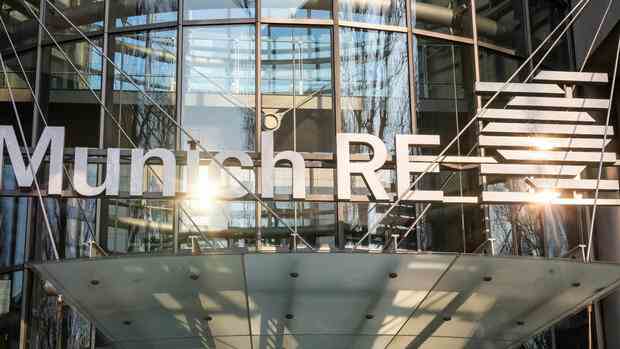The reinsurer continues to grow profitably.
(Photo: dpa)
Munich Despite a large number of different major claims, Munich Re exceeded its own expectations in the past financial year. With a total of 3.4 billion euros, the Dax group earned around 100 million euros more than predicted, as the company announced on Thursday morning.
The final quarter in particular brought a profit boost for the world’s largest reinsurer. Both the reinsurance and the primary insurer Ergo, which belongs to the group, increased significantly and achieved a profit of 1.52 billion euros in the months from October to December. After nine months, there was a profit of only 1.9 billion euros at this point.
“Our broadly diversified business portfolio not only makes us more resilient, but also opens up new earnings opportunities,” said CEO Joachim Wenning in a statement. After approval by the Annual General Meeting, the dividend should be EUR 11.60, which is five percent more than in the previous year.
In particular, Hurricane Ian, which caused devastation in Florida in September, drove up the reinsurers’ loss amounts. With 1.6 billion euros, Munich Re was the most heavily burdened in the industry. In this context, Swiss Re reported losses of 1.3 billion dollars, Hannover Re was only slightly affected with charges of 276 million euros.
Munich Re also felt the effects of man-made major losses. They rose by almost half to 1.74 billion euros. The burdens from the Russian war of aggression in the Ukraine, which led to claims payments of 475 million euros, stood out.
High demand for insurance coverage
However, the losses from natural catastrophes and the difficult global political environment also meant that customer demand for insurance cover increased in all business areas. That drove premium income up. In reinsurance, Munich Re recorded payments of more than 48 billion euros – an increase of more than 16 percent compared to the same period last year.
After years in crisis mode, the primary insurer Ergo is increasingly growing into the role of a solid profit maker. After the profit forecast for the Düsseldorf subsidiary was raised significantly from EUR 600 million to EUR 800 million in the autumn, this mark was also exceeded in the final statement at EUR 826 million.
Ergo owed the significant increase in profits to the German property and casualty insurance segment. Here, the Group was able to improve the combined ratio to 90.6 percent from 92.4 percent in the previous year, despite a large number of major losses. The following applies to insurers: the lower this number is below one hundred percent, the higher the return.
Investment problems
On the other hand, things were not going so well for Munich Re when it came to investments. The investment result fell by almost a third to 4.9 billion euros. This was primarily due to losses on derivatives on fixed-income securities. The turnaround in interest rates and the associated slump in bonds brought many large investors considerable losses last year. In addition, there were write-downs on shares and bonds amounting to 850 million euros due to the Ukraine war.
The return on investment of the approximately EUR 220 billion portfolio was 2.1 percent, after 2.8 percent in the previous year. Last summer, the group reduced its return expectations for its own investments: from 2.5 percent to “more than 2.0 percent” for the year as a whole.
The reinsurer also has potential for improvement in return on capital employed (ROE). This was 13.5 percent last year. In the fall, the group had raised its expectations. Accordingly, the return on equity should range between 14 and 16 percent in the future, after previously 12 to 14 percent.
Big change in the balance sheet
For the current year, Munich Re is expecting a record consolidated profit of four billion euros. Reinsurance should contribute 3.3 billion euros and ergo 700 million euros to this. Overall, it would be around 600 million euros more than in the previous year.
However, the figures are not directly comparable. This is mainly due to the introduction of the new international accounting standard IFRS 17, which tends to lead to more profit and a higher return on equity, as the Dax group reported in December.
The turnover, which will take the place of the previously reported gross premiums, is likely to be significantly lower in the current year. Munich Re forecasts 58 billion euros. The return on investment should be at least 2.2 percent.
For listed insurers, the transition to the IFRS 17 accounting standard is one of the biggest change projects of the past few decades. For well over 20 years, the industry has been concerned with how the previously applicable standard IFRS 4 can be presented more consistently, clearly and transparently. With the introduction of IFRS 17, weaknesses in the old standard should be eliminated.
Among other things, profitability increases with the new accounting standard. In the largest business segment, reinsurance in the area of property and casualty insurance, the combined ratio is expected to be 86 percent in the future. That would be a good ten points more than in the old IFRS 4 world.
More: Companies are demanding more courage from insurers for digital transformation
